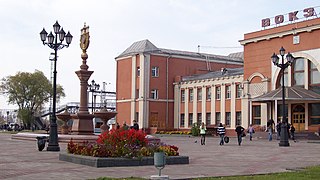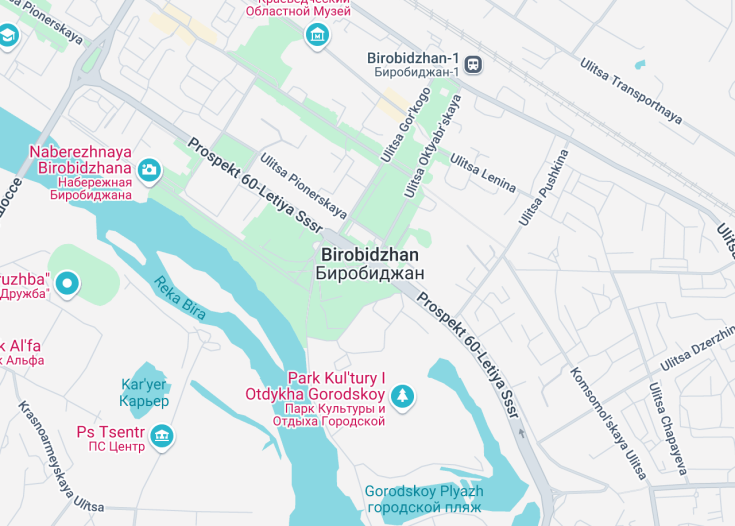Birobidzhan, the administrative center of the Jewish Autonomous Oblast in Russia, offers a unique blend of Jewish and Russian cultures. This remote region, founded during the Soviet era as a homeland for Jews, features both Yiddish influences and Soviet architecture.
Visitors can explore museums showcasing Jewish heritage, participate in Yiddish folk festivals, and enjoy local cuisine infused with traditional Jewish flavors. The town’s scenic location near the Trans-Siberian Railway also makes it an intriguing stop for those exploring the depths of Russia’s Far East.
Before visiting Birobidzhan, learn some basic Russian phrases; it will enhance your interaction with locals and enrich your travel experience.
Consider timing your visit to coincide with the Birobidzhan Jewish Culture Festival for a vibrant display of music, dance, and art.
Top things to do & see in Birobidzhan
Select the following sights and activities to discover best tickets and tours available in Birobidzhan.
Birobidzhan: A Unique Cultural Mosaic
| Country | Russia |
| Time in Birobidzhan | GMT+8 |
| Language spoken | Russian |
| Population | 75,413 (source: Latest Census Data) |
| Currency | Russian Ruble (₽, RUB) |
| Airports |
|
Birobidzhan, capital of the Jewish Autonomous Oblast in the Russian Far East, holds a unique position both geographically and culturally. Established in the 1930s as part of Stalin’s nationality policy, it was intended as a homeland for Jews within the Soviet Union. Situated near the Trans-Siberian Railway, Birobidzhan blends local Russian influences with Jewish culture, making it a notable example of ethnic and cultural coexistence.
Despite its challenging beginnings and remote location, Birobidzhan has developed its distinct identity. The city’s landscape is marked by signs in both Russian and Yiddish, reflecting its official bilingual status. Its historical significance is encapsulated in the Jewish Culture Museum, one of the few museums worldwide dedicated to the history of Jewish people in the region.
Over the years, Birobidzhan has experienced varying levels of immigration and emigration, especially with the opening of more opportunities for Jews to emigrate to Israel. However, it retains a vibrant community spirit and cultural richness. Festivals celebrating Jewish culture, including the annual klezmer music festival, attract visitors from across Russia and beyond, highlighting the city’s ongoing relevance as a cultural hub.
Economic activities in Birobidzhan are primarily centered around agriculture, light industry, and cultural tourism. Its strategic position on the Trans-Siberian Railway also facilitates trade links between Russia’s far eastern regions and neighboring countries like China. This connectivity is poised to play a crucial role in the city’s future economic development.
Education and art are significant in Birobidzhan, with institutions such as the Sholom Aleichem Amur State University promoting higher education and research in the area. The city’s public art includes several murals and sculptures that narrate stories of its unique cultural heritage and the resilience of its people.
In conclusion, Birobidzhan stands as a testament to historical ambition and cultural diversity. Its dual heritage as a Russian and Jewish city, coupled with its picturesque settings and vibrant cultural scene, makes it a fascinating place worth exploring both for its historical depth and its ongoing cultural contributions.
Where is Birobidzhan?
Birobidzhan is situated in the far eastern part of Russia, close to the border with China.
Distances:
| Route | Distance by car | Time by car |
| Moscow to Birobidzhan | 6,200 km | Approx. 72 hours |
| Vladivostok to Birobidzhan | 761 km | Approx. 11 hours |
What is Birobidzhan famous for?
Birobidzhan is renowned for being the administrative center of the Jewish Autonomous Region, representing a unique experiment in Jewish territorial autonomy in the Soviet Union.
History
1931-1934: The Foundation and Early Development
Birobidzhan, situated in the Russian Far East, was established in 1931 under the Soviet regime. Originally conceived as the Jewish Autonomous Region, it was designed to be a homeland for Jews within the Soviet Union. The area offered a combination of economic shoals and political motives, aimed at creating a secular, socialist Yiddish-speaking entity where Jewish culture could flourish, separate from the influences of Zionism and religion. The initial settlement period involved massive infrastructural development, including the construction of roads and the establishment of agriculture and industry.
1934-1948: Consolidation and Conflict
The early years witnessed significant immigration, primarily from Soviet cities, but also from abroad, as Jews sought a new life in Birobidzhan. However, the harsh climate and remote location made it challenging. The outbreak of World War II brought additional trials, and Birobidzhan served as a refuge for those escaping the front lines. After the war, the region struggled to recover, its idealism tempered by practical difficulties and shifting political priorities within the broader Soviet framework.
1948-1991: The Cold War Era
During the Cold War, Birobidzhan experienced a slow decline. The promise of a Jewish cultural renaissance dimmed as anti-Semitic policies and broader Soviet anti-religious campaigns took their toll. The population diversified ethnically as non-Jewish settlers arrived, diluting the region’s original purpose. Industry and agriculture remained the primary economic activities, but isolation hindered growth, and Birobidzhan became one of the lesser-known corners of the USSR.
1991-Present: Post-Soviet Era and Modern Days
Following the dissolution of the Soviet Union in 1991, Birobidzhan confronted new realities as part of the Russian Federation. It saw a resurgence of interest in its Jewish heritage, and efforts were made to revive Yiddish culture and promote tourism linked to its unique history. Economic challenges persist, and while the Jewish population has diminished significantly, Birobidzhan continues to symbolize a fascinating experiment in ethnic and cultural autonomy.
Visit Birobidzhan
What to see and do in Birobidzhan, Russia.
Travelers to Birobidzhan can explore a variety of cultural and historical landmarks that highlight its unique Jewish heritage and the region’s natural beauty. Key attractions include:
- The Birobidzhan Synagogue, which stands as a symbol of the Jewish culture in the region.
- The Birobidzhaner Shtern monument, commemorating the Jewish settlers of the region.
- The Sholom Aleichem Amur State University, which offers insights into local education and cultural practices.
- Local nature reserves, showcasing the stunning biodiversity of the Russian Far East.
Additionally, visitors can engage in bird watching or hiking in the surrounding natural parks, providing a serene escape into nature.
Seasonal Events in Birobidzhan
Birobidzhan hosts several cultural events that reflect its diverse heritage. Noteworthy among them is the Birobidzhan Jewish Music Festival, typically held in the summer, which features a mix of traditional Jewish and local music.
Another significant event is the city’s anniversary celebration every April, marked by parades and public concerts, celebrating its establishment and unique history.
Best time to visit Birobidzhan
The ideal time to visit Birobidzhan is during the late spring and early summer months, from May to July. During this period, the weather is comfortably warm, allowing for pleasant exploration of the city and its surroundings. The natural landscapes are particularly vibrant, and the local festivals add a lively cultural dimension to the visit.
Is Birobidzhan worth visiting?
Birobidzhan offers a unique blend of cultural history and natural beauty. Its appeal lies in its status as the world’s first Jewish Autonomous Region, which makes it a significant site for those interested in Jewish history and culture.
However, its remote location and limited tourist infrastructure can pose challenges for visitors. For those intrigued by its unique story or seeking off-the-beaten-path adventures in Russia’s Far East, Birobidzhan is certainly worth a visit. The city’s effort to revive its cultural heritage and the serene natural environment can provide a meaningful travel experience, albeit with some logistical planning required.










